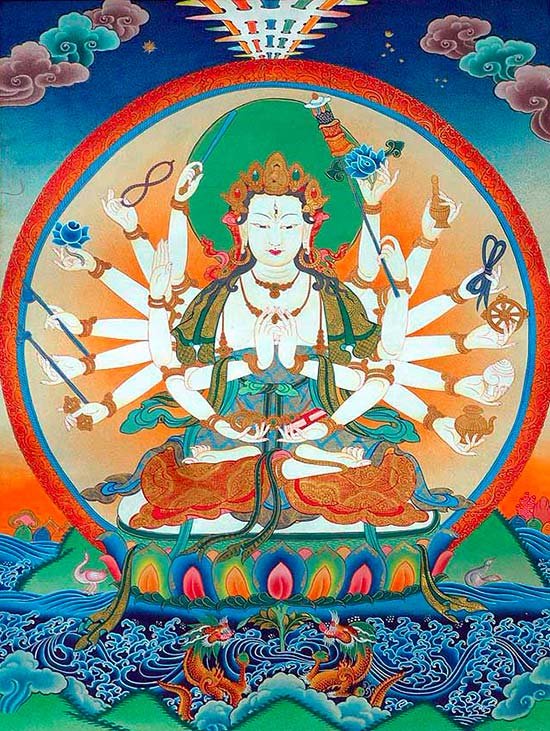Maha Prajnaparamita Sastra
by Gelongma Karma Migme Chödrön | 2001 | 941,039 words
This page describes “udana (exclamation)” as written by Nagarjuna in his Maha-prajnaparamita-sastra (lit. “the treatise on the great virtue of wisdom”) in the 2nd century. This book, written in five volumes, represents an encyclopedia on Buddhism as well as a commentary on the Pancavimsatisahasrika Prajnaparamita.
Fifth aṅga (member): Udāna (exclamation)
1) The yeou-t’o-na (udāna) ‘exclamations’ are called yeou-fa.[1] When the Buddha needed to speak and nobody was questioning him, he elicited a question by a short exclamation.
[Udānasūtra].
2) Furthermore, as is said in the Prajñāpāramitāparivarta,[2] the devaputras applauded Subhūti on one occasion, exclaiming: “Good! Very good! Very rare is the Blessed One; exceptionally rare is the appearance of the Blessed One!” – That [307b] also is called udāna.
3) Furthermore, after the parinirvāṇa of the Buddha, his disciples gathered and copied yao-kie ‘summary verses’ (uddāna?); verses about impermanence made up the chapter on impermanence (anityavarga) and so on up to the verses on the brāhmaṇa which made up the chapter on the brāhmaṇa (brāhmaṇavarga). – That also is called udāna.[3]
4) The collections of wonderful things are also called udāna.
Texts of this kind show the characteristics of the udānas.
Notes on Udāna:
In general, any literary composition where, under the influence of joy or sadness, an ‘exclamation’ is uttered, most often in the form of gāthā, can be called udāna. Here the Traité is going to use as example a sutta from the Saṃyutta (III, p. 55–58) entitled precisely Udāna; but the examples may be infinitely multiplied, as the expression udānam udānayati ‘to utter and exclaim’ is often met in the canonical texts. The exclamation is not always made by the Buddha: it may also be uttered by the deities or by the disciples.
But udāna can also designate a given Buddhist work: for example, a collection of verses compiled after the Buddha’s parinirvāṇa dealing with the grand subjects of the religion. This collection had been divided into chapters (varga), the first dealing with impermanence (anitya) and the last with the brāhmaṇa. This brief description can be applied only to the Udāna of Eastern Turkestan, one of the minor texts classified by the Sarvāstivādins into the special collection of the Kṣudrakāgama or Kṣudrakapiṭaka (cf. Mūlasarv. Vin., Gilgit Manuscripts, III, part 4, p. 188, l. 8; T 1448, k. 3, p. 11b6; Divyāvadāna, p. 20, l. 23; 34, l. 29; Saṃyuktāgama, T 99, k. 49, p. 362c10. This Udāna of the North, according to F. Bernhard’s edition (1965), consisted of 33 chapters, the first of which is entitled Anityavarga and the last, Brāhmaṇavarga. In the west, this work has long been designated under the title of Udānavarga, but F. Bernhard has shown that udānavarga is a common name meaning ‘the vargas (chapters) of the Udāna’, and that the work was really called Udāna (Zum Titel des sogenannten Udānavarga, Sonderdruck der ZDMG, Supplementa I, 1969, p. 872–881). With the Dharmapada which is similar to it, the Udāna was the object of a Tibetan translation (Otani Kanjur Catalogue, no. 992) and four Chinese versions or adaptations (T210 to 213); see L. Schmithausen, Zu den Rezensionen des Udānavargaḥ, Wiener Zeitschrift für die Kunde Südasiens, XIV (1970), p. 47–124); C. Willemen, The Chinese Udānavarga, 1978, p. XIII-XXVIII.
The Traité is going to talk about the yao-kie ‘summary verses’ of this Udāna. But the work contains only rare summary-stanzas, in Sanskrit uddāna (ed. Bernhard, p.184, 277, 510). As a result of homophony, confusion between udāna and uddāna was inevitable, but udāna comes from the root ud-an ‘to expire upwards’ whereas uddāna is derived from the root ud-dā (dayati) ‘to join, to condense’.
Footnotes and references:
[1]:
Here yeou-fa probably renders the typical exclamation aho dharmam “Ah! The Dharma!” which appears several times in the Mahāvastu, I, p. 236, l. 18; 237, l. 3; 241, l. 12; II, p. 143, l. 18; 406, l. 11: aho dharmam udīrayensuḥ. The expression already appeared in the fourth Rock Edict of Aśoka (ed. J. Bloch, Inscriptions d’Aśoka, p. 98): bherīghoso aho dhaṃmaghoso, which is to be translated not as “the sound of the drums has become (aho, imperfect of hoti) the announcement of the Dharma”, but as “the sound of the drums and the cheering of “Ah! the Dharma!” according to the interpretation of L. de La Vallée Poussin, L’Inde aux temps des mauryas, 1930, p. 110).
Gods and humans often utter the exclamation “O happiness!” (udānaṃ udānenti ‘Aho sukhan ti’); cf. Dīgha, III, p. 218; l. 23–24; Anguttara, III, p. 202, l. 13; Pāli Udāna, p. 18, l. 22–23.
[2]:
Later (k. 40, p. 353b18; k. 53, p. 441b2), mention will be made of this Prajñāpāramitā-parivarta although this title does not appear in the table of contents of T 223. The Traité is referring here to a passage from the Pañcaviṃśati, T 223, k. 14, p. 325b, chap. XLIX entitled Wen-siang-p’in. The same passage occurs in the Aṣṭasāhasrikā, ed. Wogihara, p. 560: Atha khalu Śakradevendrapramukhāḥ kāmāvacarā rūpāvacarāś ca devaputrā brahmakāyikānāṃ ca viṃśatidevaputrasahasāṇi yena Bhagavāṃs tenopasaṃkramya Bhagavataḥ pādau śirasābhivandyaikānte tasthuḥ | ekāntasthitāś ca te kāmāvacarā rūpāvacarāś ca devaputrā Bhagavantam etad avocan | gambhīrā Bhagavan dharmāḥ prakāśyante kathaṃ Bhagavann atra lakṣaṇāni sthāpyante.
[3]:
For the author of the Traité, the group called ‘udāna’ is represented by the Sanskrit Udāna of Eastern Turkestan consisting of 3 vargas, the first of which deals with anitya and the last with the brāhmaṇa. For Buddhaghosa (Commentary on the Vinaya, I, p. 28,) it is represented by the 82 suttantas of the Pāli Udāna.
